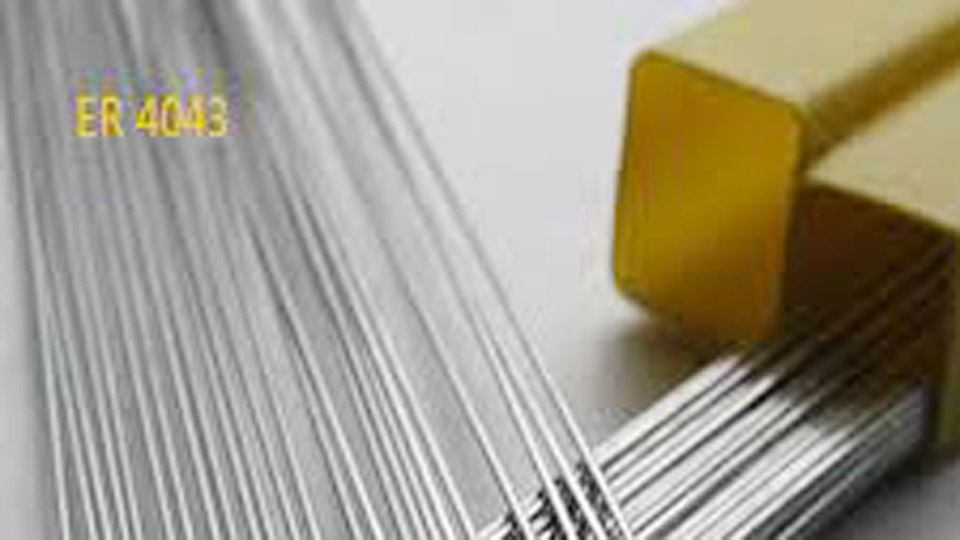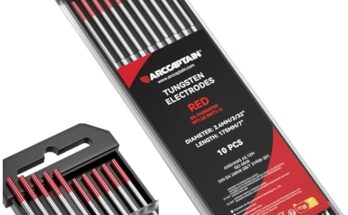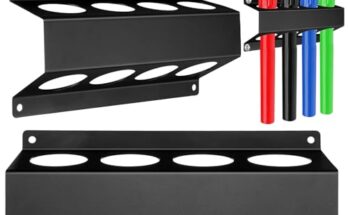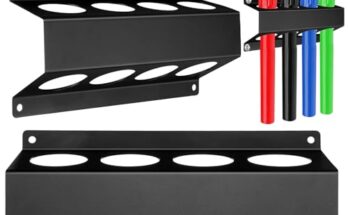Hey there, if you’ve ever picked up an aluminum welding rod and wondered, “What exactly is the 4043 rod used for?”, you’re definitely not alone.
I’ve worked with this rod quite a few times, and I can tell you it’s one of the go-to choices when dealing with certain types of aluminum jobs.

Image by focusweld
If you’re just starting out with welding or you’ve got some sparks under your belt, understanding the purpose and benefits of the 4043 rod can save you time, money, and frustration.
I’m going to walk you through everything you need to know about the 4043 welding rod—from what it’s made of, when to use it, why it’s preferred for some jobs and not others, and even the little tips I’ve picked up over time that can really help your welds shine. Let’s dive in.
What is a 4043 Welding Rod?
The 4043 welding rod is a filler metal made mostly of aluminum and silicon. To break it down simply, it’s a type of aluminum alloy rod that’s commonly used in both TIG (Tungsten Inert Gas) and MIG (Metal Inert Gas) welding processes.
It contains about 5% silicon, which gives it some unique welding properties, especially when it comes to how the weld looks and how easy it is to use.
The silicon content helps the molten metal flow better, which means cleaner, smoother welds. And if you’re someone who appreciates a good-looking bead, this rod is your friend.
Why is 4043 Welding Rod So Popular?
From my own experience and talking with other welders, I can say the 4043 rod is a favorite for a few solid reasons.
First, it’s easy to work with. Even if you’re a beginner, it gives you a bit more forgiveness. It also produces less crack sensitivity than some other aluminum rods, especially the 5356.
Here are some of the main reasons people prefer it:
- Excellent weld appearance
- Good corrosion resistance
- Low spatter
- Smooth arc characteristics
- Reduced risk of cracking
All of these things make it a great rod for general aluminum repairs and fabrication.
Common Uses of 4043 Welding Rod
The 4043 rod isn’t for every aluminum welding job, but it covers a lot of ground. Let me walk you through the most common applications.
Welding 6061 Aluminum
If you’ve got a project involving 6061 aluminum (which is a super common alloy in construction, automotive, and general fabrication), 4043 is one of the best rods to use. It bonds well and holds up in moderate structural applications.
Automotive Repairs
A lot of aluminum in cars—especially older models and aftermarket parts—can be welded with 4043. It works well for repairing things like intake manifolds, aluminum wheels, and engine parts, assuming you’re dealing with compatible alloys.
Structural Fabrication
If you’re fabricating non-critical structures where aesthetics matter—like railings, decorative metalwork, or frames—this rod delivers great-looking welds with minimal cleanup.
HVAC and Piping Systems
In HVAC work, aluminum tubing and components sometimes require TIG welding with 4043 rods. The rod’s smooth flow helps keep the work clean, especially in tighter spaces.
Boat and Marine Repairs
While it’s not the best option for saltwater-heavy environments (since 5356 might be better for corrosion resistance there), 4043 is still used for light-duty marine repairs and non-structural components.
Chemical Composition of 4043 Rod
Here’s a quick table that breaks down what the 4043 filler metal is made of. Understanding the makeup helps explain why it performs the way it does.
| Element | Percentage |
|---|---|
| Aluminum (Al) | Balance (Main) |
| Silicon (Si) | 4.5% – 6.0% |
| Iron (Fe) | Max 0.8% |
| Copper (Cu) | Max 0.3% |
| Manganese (Mn) | Max 0.05% |
| Magnesium (Mg) | Max 0.05% |
| Zinc (Zn) | Max 0.10% |
| Titanium (Ti) | Max 0.2% |
This blend is designed for optimal flow and reduced cracking, especially when welding certain aluminum alloys.
Best Aluminum Alloys to Use with 4043 Rod
Not all aluminum alloys are compatible with 4043. You’ll get the best results when using it with the following:
- 3003
- 6061
- 6063
- 5052 (only in some situations)
- 7005 (non-structural only)
These alloys bond well and the welds tend to hold up nicely for most non-critical applications.
When Not to Use 4043 Welding Rod
Now, just because this rod is great doesn’t mean it’s perfect for every job. There are times when I’d avoid it altogether.
- High-strength welding: If you’re working on a load-bearing structure that demands high tensile strength, 5356 is often the better choice.
- Welding anodized aluminum: 4043 can struggle with bonding anodized surfaces unless the anodizing is removed.
- Marine environments: Saltwater can be harsh, and while 4043 has decent corrosion resistance, it’s not the best pick for salt-heavy conditions.
Always double-check your base material and service conditions before choosing your filler rod.
Advantages of 4043 Welding Rod
Let me run you through the reasons I personally love working with this rod. It’s great for both beginners and experienced welders.
- User-Friendly: Super easy to strike and maintain an arc, especially with TIG.
- Smooth Weld Beads: It lays down nicely and looks great even before post-cleaning.
- Reduced Hot Cracking: Compared to rods with higher magnesium, this one handles stress better as it cools.
- Good Corrosion Resistance: Not the best, but more than enough for indoor or mild outdoor exposure.
- Wider Compatibility: Works with several popular aluminum alloys.
Disadvantages of 4043 Welding Rod
There are some trade-offs, and it’s good to know them before you start a project.
- Lower Strength: It’s not as strong as 5356 or other high-strength rods.
- Not Great for Anodizing: The weld will look different than the anodized base metal.
- Limited Use in Harsh Environments: Saltwater, heavy chemicals, or extreme temperatures might call for another alloy.
Knowing both sides helps you make the right call.
TIG vs MIG Welding with 4043 Rod
You can use 4043 with both MIG and TIG welding, but the process feels a bit different depending on what you’re doing.
TIG Welding
TIG gives you better control and precision, which is ideal for thin materials or clean, detailed work. I personally prefer TIG for most aluminum repairs with 4043, especially when appearance matters.
MIG Welding
If you’ve got a larger job or thick materials, MIG is faster. The rod comes in spools for MIG welding, and it feeds smoothly because of its silicon content. But you’ll want to dial in your settings just right, or you could end up with cold starts or undercuts.
Tips for Using 4043 Welding Rod
Here are a few tips I’ve picked up from my own experience:
- Clean thoroughly: Aluminum oxide is your enemy. Use a stainless steel brush and acetone.
- Preheat thicker materials: This helps prevent cracking and improves penetration.
- Use the right shielding gas: Pure argon is the go-to for aluminum.
- Store properly: Keep your rods dry. Moisture can cause porosity in the weld.
- Practice your technique: Aluminum is a different beast. Keep your motion steady and avoid lingering.
How to Identify a 4043 Welding Rod
Most 4043 rods are marked with a small stamp near one end, especially if they come in packaging from a reliable brand. You’ll see something like “4043” etched or printed. If you’re using wire for MIG, the spool should be labeled clearly.
Also, the rod has a distinct silver-gray appearance, and it tends to feel slightly slick due to the silicon.
Safety When Using 4043 Welding Rod
Safety first, always. Aluminum welding, especially with TIG, generates intense UV light and fumes.
- Wear proper PPE: Gloves, helmet with the right shade, long sleeves.
- Work in a ventilated area: Use fume extractors or work outdoors if possible.
- Watch your posture: TIG especially can have you bent over for long periods.
Don’t let comfort slip—welding can be physically demanding if you’re not mindful.
Storage Tips for 4043 Rods
Aluminum rods are sensitive to moisture and contamination. Here’s how I keep mine in top shape:
- Store in sealed containers or rod tubes
- Avoid high humidity areas
- Wipe them down before use
- Label and separate by alloy to prevent mix-ups
Good storage extends the rod’s life and keeps your welds clean and solid.
My Personal Experience with 4043 Rods
I’ve used 4043 on all kinds of jobs—from patching up an old aluminum boat hull to repairing cracks in a transmission housing.
One thing I’ve always appreciated is how predictable it is. It’s not flashy or super strong, but it’s reliable, smooth, and forgiving. If I’ve got a non-critical weld and I want it to look good, I reach for 4043 almost every time.
Conclusion
So, what is the 4043 welding rod used for? It’s a trusted, go-to aluminum filler rod for a wide range of applications.
From automotive repairs and structural fabrication to HVAC and marine tasks, it’s loved for its smooth arc, clean finish, and ease of use. It’s not the strongest or the most corrosion-resistant, but it finds the perfect balance for everyday jobs.
If you’re just starting out, it’s an ideal rod to get familiar with aluminum welding. And if you’re experienced, you already know how valuable it can be for the right task.
Just remember to check your base metal, prep well, and match your process to the job. When used correctly, the 4043 rod delivers some beautiful results.
FAQs
What metals can I weld with a 4043 rod?
You can weld most aluminum alloys like 3003, 6061, and 6063. It’s not suitable for magnesium-rich alloys or high-strength structural parts.
Can I use 4043 for TIG welding only?
No, 4043 is available for both TIG and MIG welding. You can get it in rod form or spools depending on your setup.
Is 4043 better than 5356?
It depends on your job. 4043 offers better crack resistance and appearance, while 5356 is stronger and more corrosion-resistant.
Why is silicon added to 4043 rods?
Silicon helps improve the fluidity of the molten metal, making it easier to control and resulting in smoother welds.
Will 4043 welding rod match the color of anodized aluminum?
No, unfortunately, it won’t. The weld will usually appear darker than the anodized surface.


